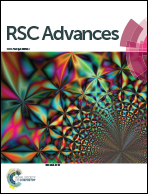Synthesis, structural characterization, and chemical properties of pentacoordinate model complexes for the active site of [Fe]-hydrogenase†
Abstract
Based on the synthesis of two new hexa-coordinate N-heterocyclic carbene (NHC) substituted precursors FeI2(CO)3(NHC) with NHC = IPr (1,3-bis(2,6-diisopropylphenyl)imidazol-2-ylidene) (2) and NHC = SIPr (1,3-bis(2,6-diisopropylphenyl)imidazol-2-ylide) (3) and two known complexes FeI2(CO)3SIMes, SIMes = (1,3-bis(2,4,6-trimethylphenyl)-imidazol-2-ylide) (1) and FeI2(CO)3IMe IMe = 1,3-bismethylimidazol-2-ylidene (4), four new mononuclear [Fe]-hydrogenase model complexes Fe(CO)2(NS)(NHC) (NS = aminothiophenol; 5, NHC = SIMes; 6, NHC = IPr; 7, NHC = SIPr; 8, NHC = IMe) were prepared by substitution of two iodine ligands with the help of dipotassium-aminothiophenol salt and subsequently the absence of a CO ligand. New complexes 2, 3 and 5–8 were fully structurally characterized by infrared spectroscopy (IR), elemental analysis, NMR spectroscopy, and X-ray crystallography. IR spectroscopy studies show that complexes 5–8 exhibit similar IR patterns and absorption wavelengths in terms of ν(CO) with the active site of [Fe]-hydrogenase. The facile protonation/deprotonation of the NS ligand of complexes 6 and 7 was disclosed with the assistance of IR spectroscopy. The NS ligand accepts a proton reversibly as an internal base, generating two protonated species, [Fe(CO)2IPr(H-NS)]+ and [Fe(CO)2SIPr(H-NS)]+, which play the same role with the intrinsic cysteine thiolate ligand in [Fe]-hydrogenase. DFT results showed that the N atom of the NS ligand is the thermodynamically active proton acceptor in acetone while the NS ligand is prone to be dually protonated first in the N atom and then the S atom in the gas phase. Complex 5 exhibited simultaneous protonation and the combination of CO, forming a new mer-tricarbonyl species in the presence of CO and HBF4. It showed easy reversible deprotonation and deprivation of CO with the assistance of t-BuOK or Et3N. Also, the electrochemical properties of these new pentacoordinate model complexes were explored through cyclic voltammetry, which enabled us to identify the contributions of different NHC ligands to the complexes' redox properties.
![Graphical abstract: Synthesis, structural characterization, and chemical properties of pentacoordinate model complexes for the active site of [Fe]-hydrogenase](/en/Image/Get?imageInfo.ImageType=GA&imageInfo.ImageIdentifier.ManuscriptID=C6RA18628A&imageInfo.ImageIdentifier.Year=2016)

 Please wait while we load your content...
Please wait while we load your content...